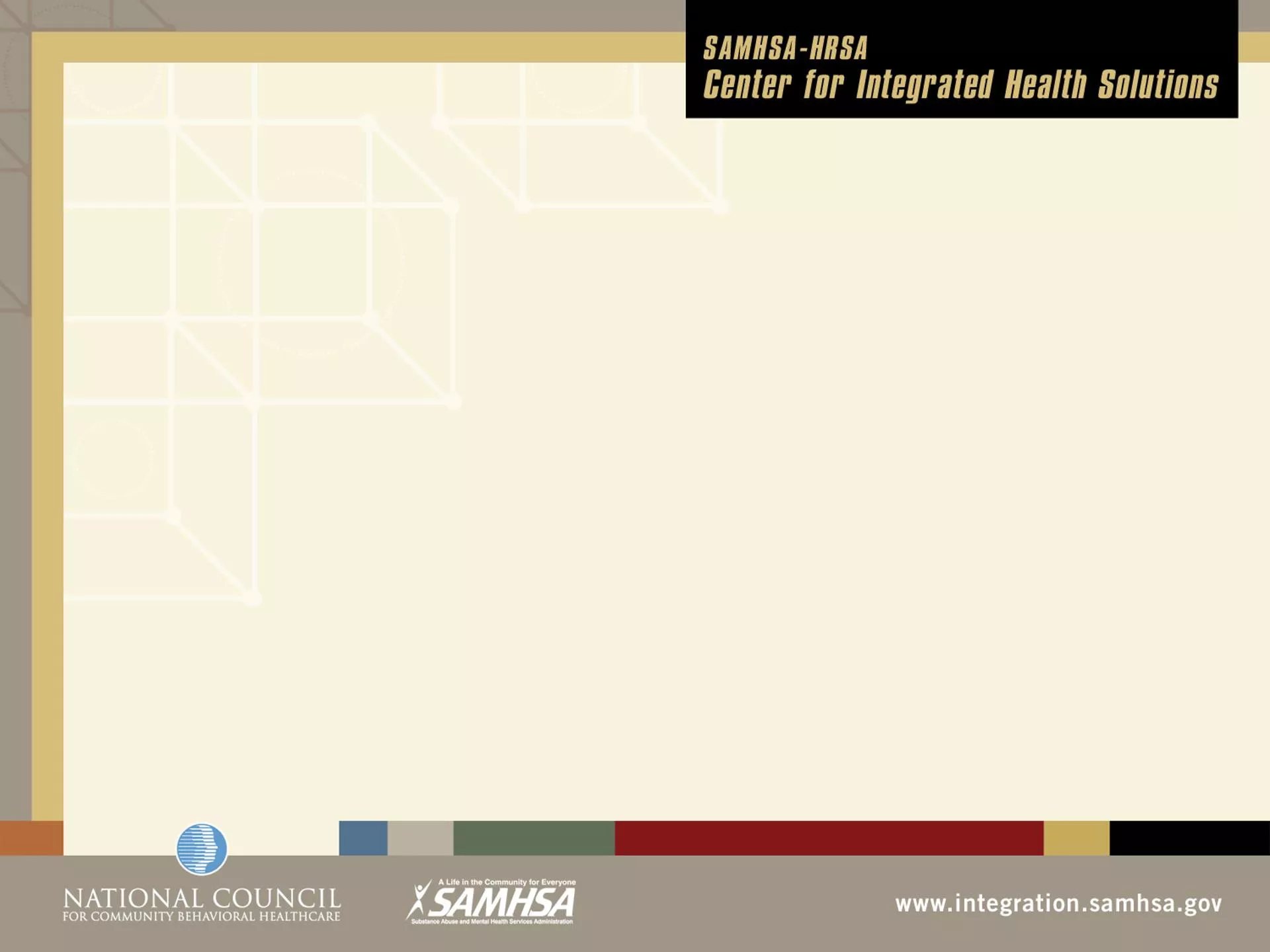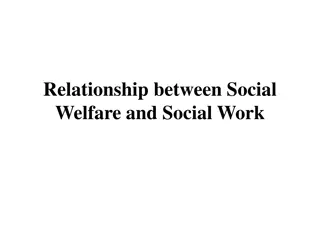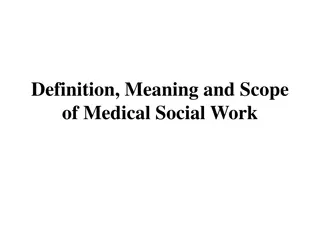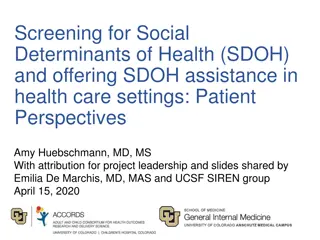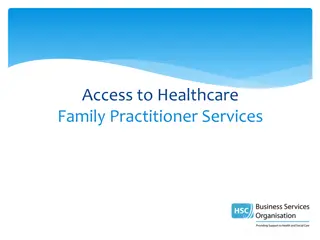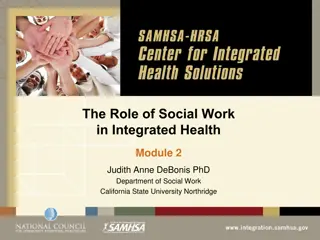The Evolving Role of Social Work in Healthcare
Changes in healthcare have led to shifts in the role of social work. From historical perspectives in medical social work to addressing current challenges in integrated health, social workers play crucial roles in patient care. The module emphasizes the importance of effective communication, teamwork, personal leadership qualities, emotional intelligence, and ethical standards in integrated health practice. Understanding these aspects is vital in navigating the complexities of modern healthcare systems.
Download Presentation

Please find below an Image/Link to download the presentation.
The content on the website is provided AS IS for your information and personal use only. It may not be sold, licensed, or shared on other websites without obtaining consent from the author. Download presentation by click this link. If you encounter any issues during the download, it is possible that the publisher has removed the file from their server.
E N D
Presentation Transcript
The Role of Social Work in Integrated Health Module 2 Judith Anne DeBonis PhD Department of Social Work California State University Northridge
Module 2 The Role of Social Work in Integrated Health By the end of this module students will: Understand the changing role of social work in healthcare Recognize the importance of clearly communicating the social work role as it relates to IH Practice skills necessary to work as an effective team member Realize the value of their personal leadership qualities in IH Be aware of the positive impact of practice and policy advocacy actions on IH Learn how emotional intelligence and relational leadership can support the need for collaboration in IH Identify special issues related to ethical standards apply to IH
Definitions, Primary Care Teams, Functions and Benefits
Significant Shifts and Changes in Healthcare Changes in healthcare have impacted the role and responsibilities of both providers and patients. These changes have also resulted in a call for new roles, new models of treatment, and new professional competencies and training 1 For example increases in the number of patients who have chronic health conditions requires a different model of treatment and more collaboration between patients and providers.2 Social Work has been interested in chronic care for close to 100 years 3
Historical Role of Social Work in Healthcare As early as 1915, medical social work was defined as a specific form of social case work focused on the relationship between disease and social maladjustment.3 With an emphasis on the social impediments to health, social workers were charged with providing some occupation or experience for the person jolted out of his regular plan of life by chronic disease, to offset what he has lost and to make him feel that he has still a useful place in the world. 3 It is an important part of the social worker s function to concern herself with the social problems arising directly out of the nature of the medical treatment. Harriet Bartlett 3 Do these concepts apply to social work and healthcare today?
Current Role of Social Work in Healthcare Little consensus in the literature as to the role of social work in healthcare A wide variety of descriptions reflecting a range of responsibilities and functions. Including broad conceptual roles such as the promotion of equality of opportunity, the advancement of social change, and the task of challenging injustice4 Responding to the call for increasing accountability, application of evidence- based practices, and cost effectiveness, there is movement in Social Work: 1. Shift to adapt and integrate as behavioral health specialists in primary care settings 2. Shift to community-based treatment models implementing evidence-based practices which serve consumers in a cost effective manner, while providing more comprehensive and integrative quality of care. 5 3. Shift to expand Social Work to include research as an important aspect of the social work role. 5,6
Then: Social Work Looked to Medicine as the Model Profession Medical Social Work did not meet the criteria for a profession: Social Work had a professional spirit but members did not have sufficient individual responsibility, lacked a written body of knowledge and educationally communicable techniques 3 Initially social work viewed medicine as a model profession and an intrapersonal approach as more professional than one focused on social and environmental factors3
Now: Medical Professionals Look to Social Work to Guide Training Tenets and principles of social work are being incorporated into the competencies and training of other healthcare providers physicians, residents, nurses. Several examples: 7 Well-trained residents/physicians are those who further the quality of care and the humanistic mission of the medical profession. Residents are required to be: Ethical, compassionate, effective at creating therapeutic relationships with patients Able to educate and empower, providing useful information to patients and families 8 Skilled at working collaboratively with interdisciplinary healthcare teams A shift in attitude toward the relationship between physician and patient- stressing collaboration, the importance of positive interactions, and the role that all contributing parties serve in meeting the patient s goals. 1 Interpersonal Communication Process Vs. Outcomes Systems Based Practice 7
What Social Work Tenets and Principles Contribute to Integrated Health Includes a wide range of settings, organizations, populations where social workers practice. Focuses on a broad range of health, mental health, as well as the social and economic aspects of the lives of individuals, groups and communities 9 Has lead to a health paradigm that more readily acknowledges a range of psychosocial contributions to the etiology, course and outcome of illness.10 Importance of a therapeutic relationship Collaboration Communication skills Resilience Advocacy Justice 7 Client Empowerment Self-Determination Social work s value to healthcare delivery remains its comprehensive view of social and psychological circumstances as they interact with health and illness, and its flexible range of helping interventions to deal with the personal, interpersonal, and environmental barriers. 10
Role of Social Work in Primary Care Defining Primary Care the provision of collaborative, accessible healthcare services by clinicians who are accountable for Primary Care Refers to Family Medicine, pediatrics, geriatrics, internal medicine not specialty care Often the first line of entry to the healthcare system for patients their medical home addressing a large majority of personal healthcare needs Role of Social Workers in PC Prevention Health Promotion Service Delivery Design Acute and Chronic Care Treatment Rehabilitation Long-Term Care 12 developing a sustained partnership with patients practicing from a biopsychosocial systems perspective in the content of family and community 7
Specific Functions: A day in the life of social workers in Primary Care Behavioral health practices must be adapted to adhere to the fast pace of a primary care setting See patients for 15-30 minutes to conduct a focused assessment and to develop a treatment plan. This information is then discussed with the Primary Health Provider (PHP) and details a behavioral health change plan. Implement, monitor, or change the intervention, using one to four 15-30 minute appointments. Behavioral Health Discuss medication side effects with patients, remind patients of skills used to reduce anxiety Arrangement for patients for AA Groups, Anger Management Groups, etc. Meet with patients during crisis situations, determining suicidality (and need for referral to community services for those patients who are already reintegrated back into their communities. Referrals, where applicable, for patients needing psychiatric services One on one and group therapy sessions Charting Sit in with presentations on issues relating to patient care (medications, nutrition) Attention to self-care 14 Use the 5 A s Assess- Gather information on symptoms, emotions, thoughts, and behaviors Advise Describe treatment options to patients Agree- Patients decide on their course of action Assist- Help patients learn new information, develop new skills, solve problems, and overcome barriers Arrange- Specify when the patient will follow-up with the provider.13
Group Activity Using the 5A and 5R Brief Intervention Models Using Brief Interventions: Highlights how essential health behaviors are to overall health Helps identify when a person is ready to make a change so that appropriate assistance can be offered Offers an opportunity to check on health behavior vitals during every visit Combining the 5 A s with the 5 R s: Use the 5 A s (Assess, Advise, Agree, Assist, and Arrange) when the person is ready and willing to make a change. Use the 5 R s (Relevance, Risks, Rewards, Roadblocks, Repetition) to educate and motivate a person who is not ready to make a change Using the 5A and 5R Handout the group will role play and practice how they would assess a person s health behavior vitals and apply the As and Rs from the models. Debrief to see what works and where more practice is needed.
How can Social Workers Function Effectively in an Interdisciplinary Healthcare Team? Skills Knowledge in: Medical Literacy Consultation Liaison skills with medical problems Population Screening Chronic Disease Management Care Management Skills Educating medical staff about integrated care Evidence-Based Interventions Group Interventions Working within the fast-paced, action-oriented ecology of primary care 15 Characteristics Ability to be: Responsive Committed to social justice Commitment to the ethical practice of social work Commitment to social change Functional independently and collectively with others Sensitive to relationships Interact positively and instructively with clients 16
Group Activity Building Skills for Effective Interdisciplinary Practice Skills Knowledge in: Medical Literacy Consultation Liaison skills with medical problems Population Screening Chronic Disease Management Care Management Skills Educating medical staff about integrated care Evidence-Based Interventions Group Interventions Working within the fast-paced, action-oriented ecology of primary care 15 of the daily care necessary to keep the condition under good control. Put Skills and Knowledge into Action Have students identify and briefly share their knowledge on one of the skill topics listed Discuss as a group how that skill might be applied to different practice settings and clinical scenarios Role play an interaction related to the skill highlighting the social work Characteristics that were observed (from the previous slide) Example: A student is working to increase their knowledge about diabetes as a chronic condition. The role play might offer a chance for the student to discuss with a patient who has been managing diabetes for many years, the challenges and stress
Social Workers as Leaders *Note: There are multiple leadership models. Blanchard (2009) model was chosen because it applies to leadership for individuals as well as self-leadership.
Defining Leaders and Leadership leaders
Famous Leaders Presidents, patriots, world leaders, inventors, explorers, educators, authors, religious leaders, activists Abraham Lincoln Walt Disney Dalai Lama Rev. Martin Luther King, Jr. Mahatma Gandhi Mother Teresa Bill Gates Rosa Parks
Everyday Leaders Not as visible or famous but may have enormous impact and be responsible for incredible change Teachers Parents Neighbors Boy Scout Leaders Team Coach Veterans
Group Activity Qualities of Leaders Instructions The goal is to record some of your personal strengths as a leader. Think about: People who acted as leaders in your life A time or situation when you acted as a leader Identify the leadership qualities that you exhibited and posses. Are these qualities also present in the people you identify as leaders?
The Good News All leaders have a cause that motivates them to act. Leaders will sacrifice and persevere to achieve their vision. No one is born a leader but leadership capacity and qualities can be developed 17
The Serve Model 17 ee the future Envision a picture of the preferred future ngage and develop others Invested in a cause, and inspire others to collaborate toward success einvent continuously Lifelong learners who put new information to good use Progress and success can be measured in outcomes and partnerships alue results and relationships mbody the values Talking the talk and walking the walk
Using Leadership to Enhance Health 18 Developing self-leadership skills can help individuals to participate more fully in a partnership with healthcare providers. Patients who are self-leaders will experience an internal satisfaction with decision making and taking actions that enhance their health.
Group Activity Identifying Leadership Qualities in Patients Think about a patient that you ve met and talked with recently. What leadership qualities did that person possess? How were each observed? Was the quality included as part of the discussion? How could that one quality be used by the patient to enhance their health? Consider how you would incorporate this information into your next visit with the patient.
Serve Model 17 Revisited and Applied to Self-Leadership Self-Leaders How Am I Doing? Can I describe what it would look like when the change is made? Know the changes they want to make Are optimistic that change is possible Am I recognizing what I m already doing, no matter how small, toward achieving that goal? Identify steps to take toward those goals eethe future Envision a picture of the preferred future
WHAT WE KNOW 19 Believing that change is possible is essential Investing in details about the change is more likely to lead to desired results When practiced consistently, small changes have a big impact
ngage and develop others Self-Leaders How Am I Doing? Is the goal I set for myself something that I want, or what others want for me? Aware of when they re fully engaged Focus on goals that they care about Does achieving the goal engage me? Identify strengths that serve to accomplish the goal Do I have the skills and support necessary to take action? Invested in a cause, and inspire others to collaborate toward success ngage and develop others
WHAT WE KNOW 20 Having a positive and respectful self-relationship serves as the foundation for change and helps to sustain the process. Potential rewards for change efforts provides the motivation needed to take action.
einvent continuously Self-Leaders How Am I Doing? Approach change as a learner Do I take the time to explore? Do I have the information I need? Allow for experimentation Adapt and customize What past accomplishments can I use or apply? Know what works for them Can I translate failures into opportunities? Lifelong learners who put new information to good use einvent continuously
WHAT WE KNOW 20,21 Taking time to discover means that the plan has better potential for success. If a strategy or an approach works, do more of it. If a strategy is not working, try something different. Exceptions to problems exist, and if identified, lead to a path of change.
alue results and relationships Self-Leaders How Am I Doing? Take pride in accomplishments Do I acknowledge small steps toward goals? Have a sense of self- acceptance Have I set up rewards that keep me motivated? Value both personal choices and partnerships to direct their life course Do I give myself credit for hard work and effort required? Progress and success can be measured in outcomes and partnerships alue results and relationships
WHAT WE KNOW22 Sustaining change requires reinforcement and ongoing motivation. Reviewing goals that were accomplished reinforces the actions that need to continue to sustain it. The way that one change is accomplished can be applied to other changes. Social support networks provide multiple benefits in the change process.
mbody the values Self-Leaders How Am I Doing? Have clear sense of values How does my process of making changes toward health serve others around me? Aware of how daily actions reflect values Recognize that there are numerous ways to enhance health and vitality Do I share my experiences in the change process to help others? Talking the talk and walking the walk mbody the values
WHAT WE (MAYBE) KNOW There are multiple options to show that we value our health. We can decide to participate at any time. If we commit to the value of optimal health, how we go about living that value is up to us. Relying on our leadership qualities is our own best asset to change.
Group Activity Applying the SERVE Model to Integrated Health What opportunities do each of the 5 aspects of the SERVE model offer to the patient and the social work provider? Consider the following case example: A 48 year old Latina woman was referred to the behavioral health specialist by the PCP. The patient was diagnosed with Type 2 diabetes 3 years ago and prescribed oral medication and lifestyle changes. She states that she hopes she will be able to lose weight and not need the medications anymore but the report from the PCP indicates that her recent HbA1C indicates that her condition is not well-managed. She is the primary cook for her husband, and two children (ages10 and 12) and doesn't want to cook any special meals. She says she tries to "cook healthy food and not too many sweets" but sometimes just skips meals to help lose weight. She has also started an exercise program, walking about 30 minutes at least 3 times each week. Patient was treated briefly for depression after the death of her Mother from a sudden heart attack last year but currently is not taking medication for depression or seeing her counselor.
Group Activity Understanding Why People Follow 23 Instructions from a Gallop Poll What leader has the most positive influence in your daily life? Now please list 3 words that best describe what this person contributes to your life.
How Did 10,000 People Respond? 23 In some cases over 1,000 people had listed the exact same words even though no categories or options were provided Followers have a very clear picture of what they want and need from the most influential leaders in their lives They Need... Trust Compassion Stability Hope Given that there are more than 170,000 words in the English language, this was impressive!
Taking an idealistic vision Taking an idealistic vision can be much harder work but the payoffs are enormous Do these concepts apply to social work and healthcare today?
The Need for Advocacy Jansson (2011) reports that patient care can be compromised by seven common problems that often go unaddressed when healthcare consumers and providers do not effectively engage in advocacy. 24 Both healthcare professionals and consumers must engage in advocacy to increase the odds that consumers will receive: (1) funding for care, (2) quality care based on acceptable guidelines, (3) protection of their ethical rights, (4) culturally competent services, (5) access to services in their community, (6) preventive services, and (7) attention to their mental health needs.
A Call to Action Patient advocates are needed to protect and support healthcare consumers Social work professionals are in a strategic position to become leaders in promoting the role of patient advocate: Advocates must be willing to speak on behalf of the patient, act as their representative, and coach the patient and the family to advocate on their own behalf 25 by the nature of their values, their commitment to social justice their ability to effectively communicate and engage individuals representing diverse backgrounds their application of the person in environment or psychosocial perspective 25,26
Taking Action to Protect and Assist Patients Social Workers serving as: Regularly take advocacy actions: Care Managers Expedite referrals, gather consumer information, help obtain second opinions, mediate between care providers, educate consumers on self-care management, link to inpatient and outpatient services. Medical Social Worker Navigator or Health Coach Discharge Planner
Using Influence for Successful Social Work Advocacy 24 Influence in Interpersonal Exchanges. Advocates can exert influence by drawing upon the following interpersonal experience: Expertise: Tactfully display personal knowledge, credentials, and suggest evidence-based practices Coercion: Cite adverse implications for consumer dissatisfaction, potential reputational losses Rewards: Praise physician for helping a consumer and promise to go the extra mile in the future Charisma: Become admired for putting patients first or being a team player by displaying qualities of leadership, moral authority to motivate others to follow Authority: Hold leadership positions in departments or persuade administrators to serve as intermediaries
Successful Strategies for Social Work Advocacy Engagement 24 Using Medical Culture Portray advocacy as coming from concern about consumer s well-being Present concern from a medical ethics perspective to promote multi- professional collaboration Engage physician, I bring this case to your attention so that we can provide the best services possible Employing Power-Dependence Social worker is viewed as credible when others depend on expertise Assume multiple functions beyond job description to enhance dependence Taking Initiative and Responsibility Initiate improvements in consumers health care and follow through with action Participate in in-service training sessions, rounds, case findings, contribute to medical records
Successful Strategies for Social Work Advocacy Engagement (Cont d)24 Develop Positive Track Record Positive reputation demonstrates competency and trustworthiness. Appropriate Assertiveness Assert influence that will not compromise ability to engage in future advocacy. Design Communication Strategy Communicate skillfully with various audiences in different situations. Consider audience and alter approach appropriately: Physician/Administrator- Provide options and ask for preference. Hostile audience- Create commonalities Encourage Consumer Empowerment Guide consumer confidence by informing of rights and encourage self- advocacy.
Group Activity Excessive Fatalism as a Barrier to Advocacy Jansson (2011) has described that excessive fatalism can impede a social worker s involvement in advocacy by undercutting the belief that change is possible. 24 You are a newly graduated MSW and the only social worker working in a primary care setting with 3 PCPs, 2 medical residents and 3 nurses. You have considerable experience and interest in health, mental health and substance use problems. The program director intimidates you and after your first team meeting, where you did not offer any input about issues that concerned you, you decided that any of your ideas would not be valued by the group and the only way to keep your job was to be compliant with the medical staff who appear to have all of the power. While you initially believed that your social work perspective would complement the medical services offered at the agency, you do not feel that it is possible to change the agency structure or policies and therefore have become more apathetic that the system can work to benefit what you observe as client needs. Comment on this case based on your thoughts about the social work role in Integrated Health. What strategies recommended by Jansson could be used to combat fatalistic thinking? Given a scenario that you believe might lead you to feel powerless and hopeless, what resources, knowledge, and personal capacities do you have that could assist you? In what ways does fatalistic thinking impact providers, patients, families, agencies?
Importance of Relational Leadership in Collaboration 28 Relational leadership is dispersed throughout an organization, focusing on process rather than individuals. For IH, this type of leadership is essential to creating successful settings and relationships: IH offers exciting possibilities for healthcare as an evolving model, there is no preexisting formula for how IH should operate IH organizations are likely to prioritize learning and generating knowledge about the best ways to function Simultaneously, IH models will require significant change for all stakeholders patients, providers, payors
Relational Leadership Mirrors the Spirit of Care Prescribed by IH27 Both consider the partnership/relationship essential to success Patient and Provider Provider and other providers (multidisciplinary team) All with the community Movement beyond traditional top management leaders and compliance of followers, the power structure is inclusive Can traditional primary care embrace this paradigm?

 undefined
undefined

